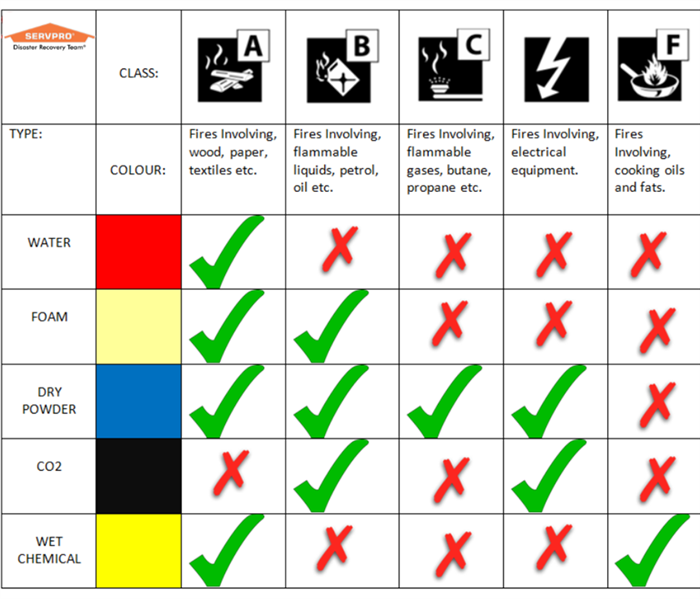What are the various types of Fires?
10/15/2021 (Permalink)
Fire Damage happens all over the county to various homes and businesses and causes massive damage to buildings, property and even to people. Fire damage is much more complicated than people may think because fire has many different types of classifications based on what the fuel source is and what type of fire it is. In this latest Blog we will review all of the different types of fires and some details about each.
Class A Fire
A Class A Fire is a widespread occurrence throughout the US and is attributed to the type of fire that is started from common household items like wood, rubber, cloth or plastic. Prevent Class A fires by keeping working areas free of trash, place oily rags in covered containers, control smoking areas, limit all sources of possible ignition and keep passages and fire doors clear at all times.
Class B Fire
Fire created from flammable liquids like gasoline, petrol, waxes, paint and oil are classified as Class B fires. Class B fires can be highly prevented if you use nonflammable substitutes for cleaners, ensure solvent tanks have fusible links on covers, keep all refuel equipment in well ventilated areas, properly store flammable liquids, ensure storage drums are properly grounded and restrict welding and cutting to authorized areas only.
Class C Fire
Most experts in the Fire community consider fires that originate from flammable gases like natural gas, butane, propane and hydrogen are considered Class C fires. Most Class C fires originate in kitchens due to most flammable gasses generally existing in kitchen spaces. Fire specialist advise homeowners to thoroughly inspect their gas ovens, gas stoves and gas burners to ensure there are no leaks before turning their appliances on.
Class D Fire
One of the absolute worst classification of fires is Class D fires which originate from combustible metals like sodium, magnesium, and potassium. We find class D fires often originate inside of very technical environments like labs or industrial businesses and generally require a professional commercial fire restoration representative to remediate it. To limit and control Class D fires work to control dust and turnings, follow established control procedures to minimize these type of fires from starting. Never use water or wet sand to try and extinguish these fires because the moisture releases oxygen which can be used to fuel the fire. Metal fires are the hottest burning fires and can reach temperatures of up to 5000 degrees. Class D fires can be one of the most difficult to extinguish.
Class K Fire
The last and final classification of Fire is Class K fires which originate from fat and cooking oils in frying pans that are left unattended or become uncontrollable and ignite on their own. These fires happen regularly in restaurants, hotel and homes and are mostly focused on kitchen areas so most firefighters call these kitchen fires. These types of fires are often overlooked but actually account for most of the fire damage that consumes homes and food-based businesses. They are difficult to put out because they combine electrical elements and flammable liquids as well.
If you have any further questions or comments please feel free to contact us at SERVPRO of East Baton Rouge at (225)753-3434 for more information on Fire restoration.





 24/7 Emergency Service
24/7 Emergency Service
